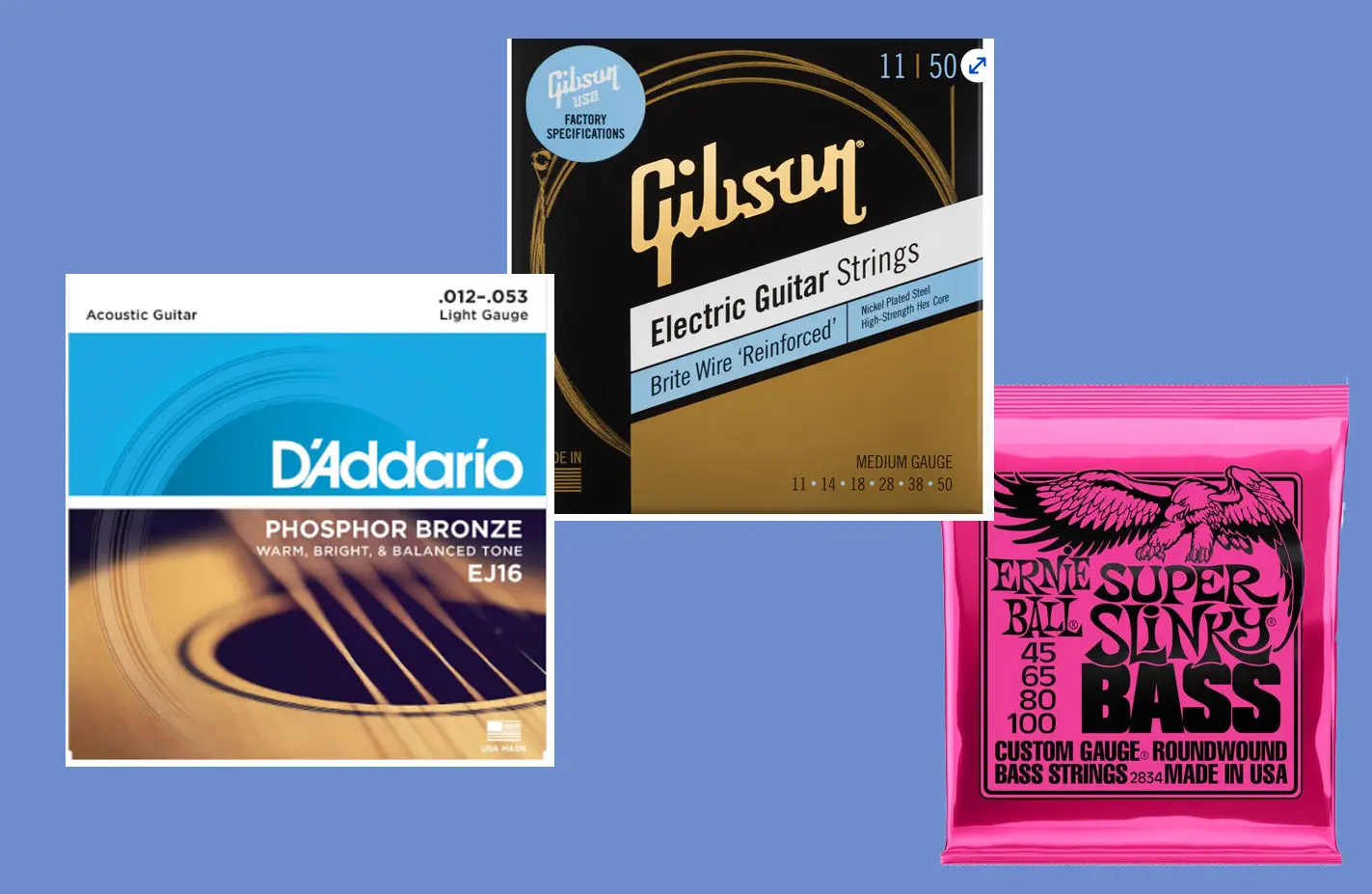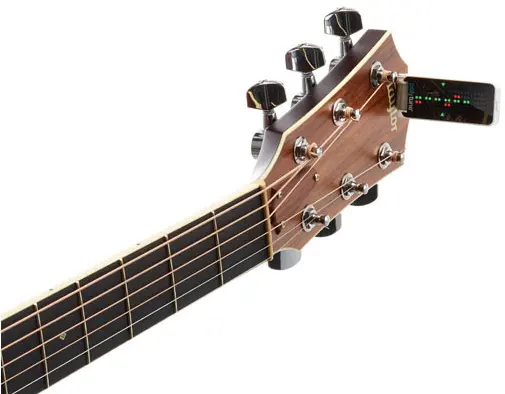
Tuning a guitar is a fundamental skill every guitar player should master. Whether you’re strumming an acoustic guitar, rocking out on an electric guitar, or laying down the groove on a bass guitar, keeping your instrument in tune is crucial to sounding your best. There are many ways to protect and maintain your guitar (visit this article on the blog to learn some general maintenance tips). This article offers some tips about guitar strings and tuning for beginners so you can quickly get started on your musical journey.
Understanding guitar strings
Guitar strings are the heart of your instrument. They vibrate to produce sound, and their tension determines the pitch of the notes you play. There are different types of strings for acoustic, electric, and bass guitars. Acoustic guitar strings are typically made of bronze or phosphor bronze, which gives them a bright, clear tone. Electric guitar strings are usually made of steel or nickel, which helps them interact with the magnetic pickups of the guitar. Bass guitar strings are thicker and produce lower pitches. One other key point to be aware of is the gauge or thickness of the strings, which can be heavy, light, and even ultra light—be cautious: the terminology used by different manufacturers of strings may vary. Lighter strings are easier on the fingers of beginning players (don’t worry, your fingers will toughen up quickly if you practice regularly). Heavier strings tend to last longer and usually will produce a richer, more sustained tone. Be sure to select the right type of string for your instrument, and keep a record of the gauge of string you use so you can adjust the gauge or stick with what you have used when you purchase replacement strings.

How often should you change guitar strings
Changing strings on a guitar depends on a variety of factors, including how often you play, your playing style, the type of strings you use, and even the acidity of your sweat. As a general rule of thumb, an average guitar player who plays regularly (say, an hour a day) might change their strings every 3 to 4 months. However, professional musicians who play daily may change their strings weekly, or even after each performance.
Acoustic Guitars: For acoustic guitars, string changes might be more frequent due to the nature of the strings. Steel strings, used on most acoustic guitars, are prone to corrosion from oils and sweat from the player’s hands. This can dull the tone of the guitar and make it harder to play. So, if you play your acoustic guitar for an hour or more every day, you might consider changing the strings every 1 to 2 months.
Electric Guitars: Electric guitars typically use nickel or stainless-steel strings which can resist corrosion better. However, they still lose their tonal quality over time and after much playing. If you play your electric guitar regularly, changing the strings every 3 to 4 months should maintain a good sound.
However, these are just rough guidelines, and the best measure is to listen to your instrument. If the guitar starts to sound dull, lacks sustain, or the intonation is off (it doesn’t stay in tune up the neck), it might be time to change the strings. Similarly, if a string breaks, it’s usually a good time to change all the strings, as the others are likely close to the end of their life as well.
Lastly, it’s important to note that every time you change your strings you will need to tune the guitar often as the newly stretched strings settle.

How to tune a guitar: the basics
Tuning a guitar involves adjusting the tension of the strings until they produce the correct pitches. Guitar players use a wide variety of turnings. The standard tuning for a six-string guitar, from lowest to highest, is E-A-D-G-B-E. Most songs you learn can be played with your guitar in standard tuning. One of the most common alternate tunings is Drop-D: the lowest E is turned down to a D. This tuning is found on many popular songs including Dear Prudence by The Beatles and All Apologies by Nirvana.
To tune your guitar, start with the low E string (the thickest one). You can use a reference pitch from a piano, a tuning fork, or an online tuner. Play the reference pitch, then play your E string. If the pitch of the E string is lower than the reference pitch, tighten the string by turning the tuning peg clockwise. If it’s higher, loosen the string by turning the peg counterclockwise. Repeat this process for each string. A helpful tip is to lower the pitch below the target, then gradually raise the pitch until it sounds the same as your reference tone. Many guitarists find it is easier to find the right pitch using this method.
How to tune an acoustic guitar
Tuning an acoustic guitar follows the same basic process as any other guitar. However, because acoustic guitar strings are made of different materials, they may respond differently to changes in temperature and humidity. It’s a good idea to let your guitar acclimate to its environment before tuning, especially if you’ve just taken it out of its case. To keep your guitar in tune for a longer period, store it in a room with relatively stable humidity (40 to 60%) and stable temperatures (not too hot or cold).
How to tune an electric guitar
Tuning an electric guitar is similar to tuning an acoustic guitar, but there’s one question that often comes up: can you tune an electric guitar without an amp? The answer is yes, you can. Electric guitars produce sound even without an amp, although the sound is much quieter. If you’re in a quiet environment, you can tune an electric guitar by ear. However, using an electric guitar tuner will give you more accurate results. Many electric guitar will be use in conjunction with one or more effects pedals and a pedal that most guitarists include in their effects set-up is a tuner pedal.
How to tune a bass guitar
Bass guitars typically have four strings, tuned to E-A-D-G from lowest to highest. The process for tuning a bass guitar is the same as for a six-string guitar, but keep in mind that the lower pitches of the bass strings can be harder to hear clearly. When tuning a bass, or tuning any kind of guitar in a noisy environment, a tuner with a visual display showing when the string is in tune can be indispensable.
Tuning a guitar without a tuner
While a guitar tuner is a handy tool, it’s also possible to tune a guitar without one. One common method is to use the fifth fret. On a guitar, the fifth fret of one string produces the same pitch as the next string up, with the exception of the B string. You can use this to tune your guitar by matching the pitches of the strings. You still need a reference pitch for the low E. Once that is in tune, pressing the low E on the fifth fret produces the reference pitch for the next string, the A string. Continue for the rest of the strings except for the B string (second last). In this case, pressing the G string on the fourth fret creates the reference tone for the B string.

How to use a guitar tuner
As mentioned above, a guitar tuner is a device that detects the pitch of a string and tells you how close it is to the desired pitch. There are different types of tuners, including clip-on tuners, pedal tuners, and apps for your phone. To use a tuner, play a string on your guitar. The tuner will show you whether the string is in tune, flat (too low), or sharp (too high). Adjust the string’s tension until the tuner indicates that it’s in tune. There is no honour is playing with an out-of-tune instrument, and guitarists of all abilities use a combination of tuner types and tuning by ear to get the right sound.
Tuning a guitar is an essential skill for any guitarist. It takes practice to do it well and to do it quickly. And, as any guitarist will attest, you will be doing it often no matter what type of instrument you play: an acoustic, electric, or bass guitar. Guitar strings need tuning regularly, especially when recently changed.
This article was drafted using AI technology and then reviewed, fact-checked, and revised by a member of our editorial team.




